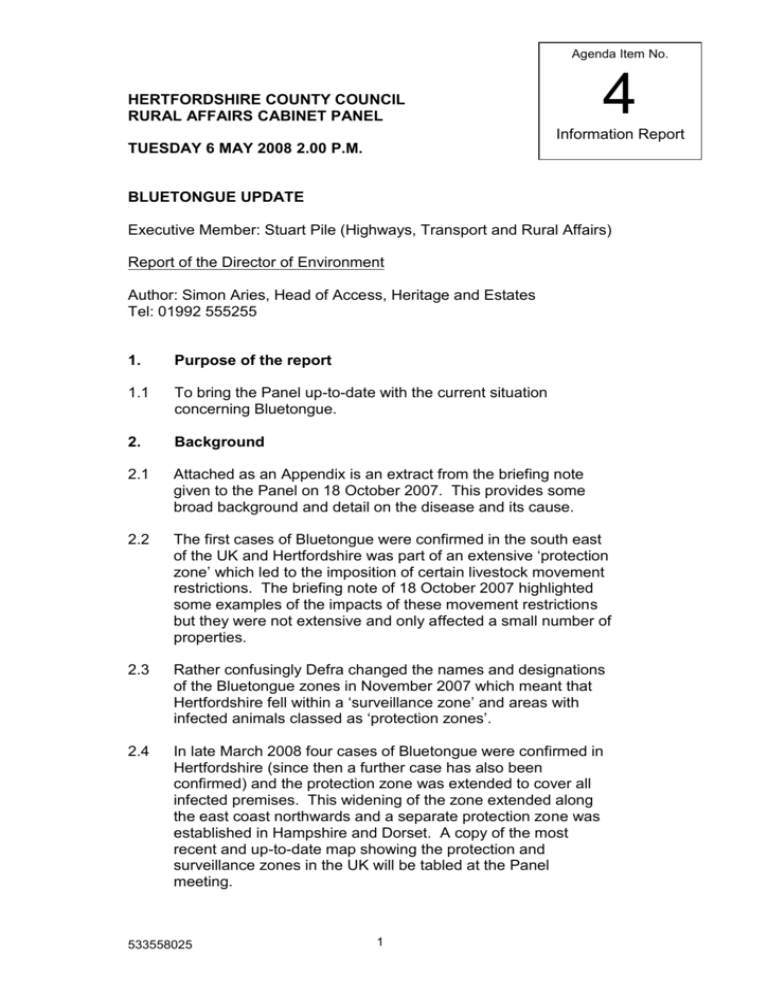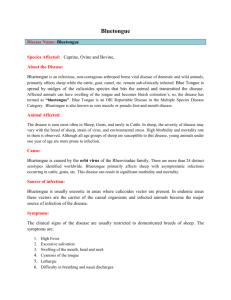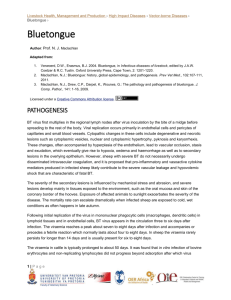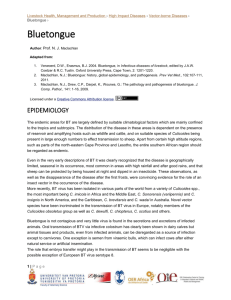Report of the Director of Environment
advertisement

Agenda Item No. 4 HERTFORDSHIRE COUNTY COUNCIL RURAL AFFAIRS CABINET PANEL Information Report TUESDAY 6 MAY 2008 2.00 P.M. BLUETONGUE UPDATE Executive Member: Stuart Pile (Highways, Transport and Rural Affairs) Report of the Director of Environment Author: Simon Aries, Head of Access, Heritage and Estates Tel: 01992 555255 1. Purpose of the report 1.1 To bring the Panel up-to-date with the current situation concerning Bluetongue. 2. Background 2.1 Attached as an Appendix is an extract from the briefing note given to the Panel on 18 October 2007. This provides some broad background and detail on the disease and its cause. 2.2 The first cases of Bluetongue were confirmed in the south east of the UK and Hertfordshire was part of an extensive ‘protection zone’ which led to the imposition of certain livestock movement restrictions. The briefing note of 18 October 2007 highlighted some examples of the impacts of these movement restrictions but they were not extensive and only affected a small number of properties. 2.3 Rather confusingly Defra changed the names and designations of the Bluetongue zones in November 2007 which meant that Hertfordshire fell within a ‘surveillance zone’ and areas with infected animals classed as ‘protection zones’. 2.4 In late March 2008 four cases of Bluetongue were confirmed in Hertfordshire (since then a further case has also been confirmed) and the protection zone was extended to cover all infected premises. This widening of the zone extended along the east coast northwards and a separate protection zone was established in Hampshire and Dorset. A copy of the most recent and up-to-date map showing the protection and surveillance zones in the UK will be tabled at the Panel meeting. 533558025 1 3. What Next? 3.1 The extent of the current protection zone and the fact that around 50% of England is now classed as a surveillance zone means that, while livestock movement restrictions are in place, their impact has diminished and the vast majority of livestock farmers are able to manage the consequences. This is helped by a licensing regime that can be used in particular circumstances to aid movement e.g. on welfare grounds, albeit under strict rules. 3.2 As Bluetongue poses no health risk to humans and cannot be spread by normal contact between animals, no access restrictions are necessary in the countryside although, where appropriate, bio security is increased as a matter of routine at infected premises. The impact of a Bluetongue outbreak on a particular farm can have serious economic consequences e.g. reduced milk production, a drop in fertility, need to quarantine stock etc. 3.3 To date, no Rural Estate tenants have had infected stock and Aldenham Country Park is operating as normal. 3.4 Early in April the Department for Environment, Food and Rural Affairs (Defra) released details of a strategy for rolling out vaccination across England. Under EU law, vaccination can only be carried out in a protection zone (of which Hertfordshire is part). As vaccine deliveries get underway (expected in early May) the programme will commence in the protection zone only. Demand for the vaccine is likely to be high but Defra have ordered 22.5 million doses and livestock keepers will be allowed to administer vaccine to their own animals. 3.5 It should be noted that the vaccine is only for the BTV8 strain that is currently circulating in the UK. Other strains of Bluetongue are present in other parts of Europe and if these were to enter the UK the vaccine would not be effective against them. 3.6 When the vaccine is available vulnerable stock at Aldenham Country Park will be vaccinated. An order is already in place and the cost is expected to be in the region of £1 to £1.50 per animal. 4. Recommendation That the contents of this report are noted. 533558025 2 Appendix BLUETONGUE Definition Bluetongue (BT) is a disease of animals affecting all ruminants, including sheep, cattle, deer, goats and camelids. It does not affect horses. Sheep are most severely affected but cattle are the main ‘carriers’ and are very important in the epidemiology of the disease. The disease is caused by a virus spread by certain types of biting midges. BT does not affect humans and poses no food safety risks. History & Spread of the Disease BT was first described in South Africa but has since been recognised in most countries in the tropics and sub-tropics. Since 1999 there have been widespread outbreaks of BT in Greece, Italy, France and Spain. Cases have also occurred in Bulgaria, Croatia, Macedonia, Kosovo and Yugoslavia. It appears that the virus has spread from both Turkey and North Africa. BT has never previously been recorded in the UK where there are no vaccines authorised for use. Vaccines have been developed in South Africa for use on local breeds of sheep but these can cause clinical disease (which may be severe) in European sheep breeds. Vaccines have been used in Europe, but this has led to transmission in the field and mixing between vaccine and field strains. Inactive vaccines are currently being developed but they are not expected to be available in the short/medium term. No vaccines are suitable against the current outbreak in Northern Europe. Cause BT is caused by a virus transmitted by a small number of species of biting midges and cannot naturally be transmitted directly between animals. However, the likelihood of mechanical transmission of the virus between and within herds/flocks by unhygienic practices (e.g. use of contaminated surgical equipment or hypodermic needles) cannot be excluded. When a midge bites an infected animal, the virus passes to the midge in the blood meal and multiples. The cycle of replication of the virus in the insect and the ruminant host, results in an increase of the amount of virus available to uninfected native hosts and vectors. Peak populations of midges occur in the late summer and autumn and therefore this is the time when BT is most commonly seen. From initial studies it is estimated that a midge can travel up to 1.5 – 2 km a day in a local area. However, if caught in suitable weather conditions midges can be carried more than 200 km. 533558025 3 Precautions taken to keep disease out of the UK All imports of susceptible animals from restricted areas in EU Member States affected by BT are banned. All susceptible animals from BT virus free EU Member States or zones (not including Ireland) are post-import tested for BT (imports back to May 2006 were tested, and have all tested negative). Daily meteorological surveillance is undertaken to assess the risk of wind borne spread of midges from affected countries to the UK. Encouraging vigilance amongst the farming community and vets to ensure early reporting of the disease (BT is a notifiable disease and suspicion of disease must be reported). Defra is raising awareness of the disease through dissemination of information leaflets to farmers and vets, through adverts in appropriate publications, and publicity campaigns at livestock markets etc. 533558025 4




